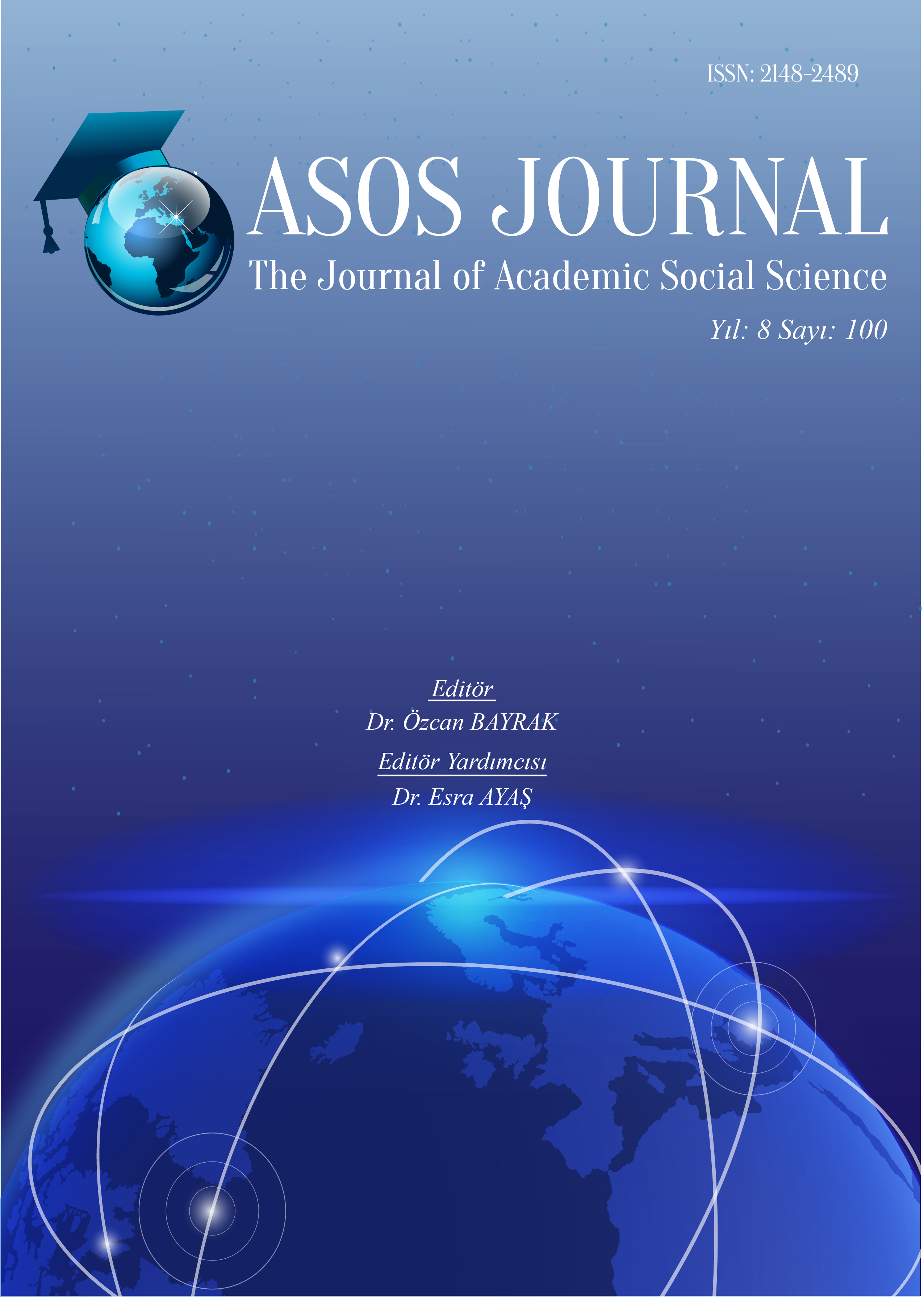Author :
Abstract
20. yüzyıl başlarında ortaya çıkan Georges Braque ve Pablo Picasso’nun öncülüğünü yaptığı Kübizm akımıyla birlikte Kolaj tekniği ortaya çıkmıştır. Kolaj tekniği elde bulunan her tür malzemeyi yüzey üzerine yapıştırmayla elde edilir. Asamblaj tekniği ise Marcel Duchamp ve Kurt Schiwitters gibi sanatçıların eserlerinde ortaya çıkan, bir teknik olarak birçok malzemenin bir arada kullanıldığı sanat eserini tanımlamaktadır. Çağdaş sanat akımları ve bunun beraberinde gelen teknikler birçok değişim ve gelişime uğrayarak dünya sanatında yer edinmiştir. Bu gelişim süreci içerisinde Bienaller çağdaş sanatın sergileme geleneği olarak ortaya çıkmıştır. Bienallerin gelişim sürecine bakıldığında geçmişten bugüne kadar sayıları hızla artmış ve birtakım değişimler yaşamıştır. Kolaj ve asamblaj teknikleri, resim sanatının kapsamını genişleterek, sadece resim değil, mimari ve heykel çalışmaları içerisinde de ele alınabilecek yeni sorunsallara konu olmaya devam etmektedir. Resim sanatında artık malzemenin altında yatan kavramın önemli olduğu, sanata düşüncenin yön verdiği görülmüş, malzemenin yönlendirdiği el becerisine dayalı sanat yapmak yerine düşüncenin sanatı yönlendirdiği hatta tuval resminde bile düşünsel alt yapı arandığı bir dönem yaşanmaktadır. Bu araştırmada 14. ve 15. İstanbul bienallerindeki kolaj ve asamblaj çalışan sanatçıların eserleri incelenmiş, analizleri yapılmıştır.
Keywords
Abstract
Along with the Cubism art movement led by Georges Braque and Pablo Picasso, which emerged at the beginning of the 20th century, Collage technique emerged. The collage technique is obtained by pasting all kinds of materials on the surface. Assemblage technique, on the other hand, was emerged in the works of artists such as Marcel Duchamp and Kurt Schiwitters, and as the art term, it refers to a three-dimensional work in which many materials are brought together. Contemporary art movements and the accompanying techniques have gained a place in world art by being undergone many changes and developments. During this development process, biennials emerged as a tradition of exhibiting contemporary art. Looking at the development process of biennials, their numbers have increased rapidly and undergone some changes from the past to the present. Collage and assemblage techniques continue to be the subject of new problems that can be handled not only in painting but also in architectural and sculpture studies by expanding the scope of painting. In the art of painting, it is seen that the concept underlying the material is important and the thought is guided by the art, and instead of making art based on the skill of the hand, the idea directs the art, even in the canvas painting, it is experienced in a period when the intellectual infrastructure is sought. In this research, the works of artists working in collage and assemblage in 14th and 15th Istanbul biennials were examined and their analyzes were made.
Keywords
- 14. İstanbul Bienali Kataloğu, (2015), Tuzlu Su (1.Baskı), Yapı Kredi Yayınları, İstanbul
- 15. İstanbul Bienali Kataloğu, (2017), İyi Bir Komşu (1.Baskı), Yapı Kredi Yayınları, İstanbul
- Erdoğan, Ferah Nur, (2007), İlköğretim Okullarında (6., 7. ve 8., Sınıflarda) Kolaj Tekni- ğinin Eğitime Katkısı. Güzel Sanatlar Eğitimi Anabilim Dalı Resim-İş Öğretmenliği Bilim Dalı Yüksek Lisans Tezi, Marmara Üniversitesi Eğitim Bilimleri Enstitüsü, İstanbul
- Eroğlu, Nazmi, (2015), Çağdaş Sanat Etkinlikleri ve Türkiye Turizmi Bağlamında 13. İstanbul Bienali İncelemesi. Yüksek Lisans Tezi, Adnan Menderes Üniversitesi Sosyal Bilimler Enstitüsü, Aydın
- Güneş, Nurhayat, (2013), Resim Sanatında Kolaj, Asamblaj Ve Türk Resmine Yansıma- ları. Güzel Sanatlar Eğitimi Anabilim Dalı Resim İş Eğitimi Bilim Dalı Yüksek Lisans Tezi, Trakya Üniversitesi Sosyal Bilimler Enstitüsü, Edirne
- Öztürk, Suzan, (2011), Resimsel Öğe Olarak Parçalılık, Biçim ve Kolaj. Yüksek Lisans Tezi. Resim Ana sanat Dalı Yüksek Lisans Tezi, Hacettepe Üniversitesi Sosyal Bilimler Enstitüsü, Ankara
- Z, Rona, (2008), Kolaj Tekniği, Eczacıbaşı sanat Ansiklopedisi, II. Cilt, 890. Yem Yayın,
- ELEKTRONİK KAYNAKÇA Sanal, 1. (2019), http://14b.iksv.org/works.asp?id=65, Erişim Tarihi: 12.05.2019. Sanal, 2. (2019), http://14b.iksv.org/works.asp?id=65, Erişim Tarihi: 21.10.2019.
- Resim-1.https://www.wikiart.org/en/kurt-schwitters/difficult-1943, Erişim Tarihi: 25.01.2018
- Resim-2.https://zhrblc.wordpress.com/2013/05/09/yeni-bir-bicimkubizm/, Erişim Tarihi: 22.02.2018
- Resim-3.https://www.pablopicasso.org/guitar.jsp, Erişim Tarihi: 23.02.2018
- Resim-4.http://acikradyo.com.tr/su-hakki/para-yoksa-su-yok-tuketime-indirgenmis-insan- doga-iliskisi, Erişim Tarihi: 30.06.2019
- Resim-5.https://kulturlimited.com/2017/10/05/elmgreen-dragsetin-istanbul-bienali- gelecek-kuratorler-icin-bir-model/, Erişim Tarihi: 30.06.2019
- Resim-6.https://www.npg.org.uk/whatson/display/2018/njideka-akunyili-crosby, Erişim Tarihi: 30.06.2019
- Resim-8.https://blog.peramuzesi.org.tr/sergiler/hafiza-ve-simdi-kumaslarda-gozde-ilkin/, Erişim Tarihi: 30.06.2019
- Resim11.https://xoxodigital.com/content/post/11610/a/iksv_15b_sahirugureren_388- medium.jpg, Erişim Tarihi: 30.06.2019 Resim-12.http://15b.iksv.org/img/participants/Latifa_Echakhch_tr.jpg, Erişim Tarihi:
- Resim-13.https://bienal.iksv.org/i/content/4107_1_15-istanbul-bienali-6.jpg, Erişim Tari- hi: 30.06.2019





